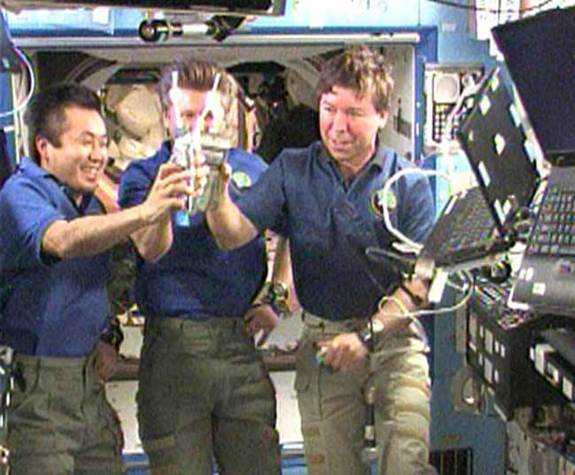Keeping the P in Space
Imagine you’re in space, floating around aboard the International Space Station. It has its upsides — you’re in space, after all! — but it’s pretty limiting at the same time. You’re trapped aboard the station, which is less than 14,000 cubic feet (or 400 cubic meters) — about the size of a large conference room with high ceilings. You can’t have a pizza delivered or anything like that, either — what you have on board is what you have available, and nothing more. Sure, those people back on Earth may send you a delivery every few months or so, but those are expensive. You have to make do with what you’ve got, and reuse and recycle like a fiend.
You’ll probably start drinking your own pee.
Actually — you will start drinking your own pee. And the pee of your crewmates, too!
In 2000, NASA published an article explaining the various issues around water use aboard the ISS and the former Russian station, Mir. As above, that water is a scarce resource in such quarters, and regularly delivering large amounts of water wasn’t economically feasible. So NASA turned to the solution: recycling. And it’s gross.
The ECLSS Water Recycling System (WRS), developed at the MSFC [Marshall Space Flight Center], will reclaim waste waters from the Space Shuttle’s fuel cells, from urine, from oral hygiene and hand washing, and by condensing humidity from the air. Without such careful recycling 40,000 pounds per year of water from Earth would be required to resupply a minimum of four crewmembers for the life of the station.Not even research animals are excused from the program.
“Lab animals on the ISS breath and urinate, too, and we plan to reclaim their waste products along with the crew’s. A full complement of 72 rats would equal about one human in terms of water reclamation,” says Layne Carter, a water-processing specialist at the MSFC.
By 2009, the WRS was up and running. As reported by Space.com, the astronauts couldn’t have been happier, even making a toast to celebrate, as pictured below.

That’s because while the reclaimed wastewater is stomach-turning in concept, it’s safe in practice. The process, per NASA, echoes that of the Earth’s biosphere:
On Earth, water that passes through animals’ bodies is made fresh again by natural processes. Microbes in the soil break down urea and convert it to a form that plants can absorb and use to build new plant tissue. The granular soil also acts as a physical filter. Bits of clay cling to nutrients in urine electrostatically, purifying the water and providing nutrients for plants.Water excreted by animals also evaporates into the atmosphere and rains back down to the Earth as fresh water — a natural form of distillation.
The space process works in the same basic way, but instead of using microbes to break down the urea, the ISS system uses something the called “forward osmosis,” which according to the American Chemical Society, works.
And it works well well: according to USA Today report (republished on ABC News’ site), NASA officials claimed that “the water from the system [is] cleaner than U.S. tap water.”
Bonus Fact: How much water is used to do laundry above the ISS? According to Canadian astronaut Chris Hadfield, none. He explained to Conan O’Brien that there are no clothes washers or dryers in space — that’d be a waste of water. Instead, the crew ejects its dirty laundry back toward Earth, where it burns up harmlessly while reentering the atmosphere.
From the Archives: Tearing Up: What happens when you cry in space.
Related: Space cups, kind of.
